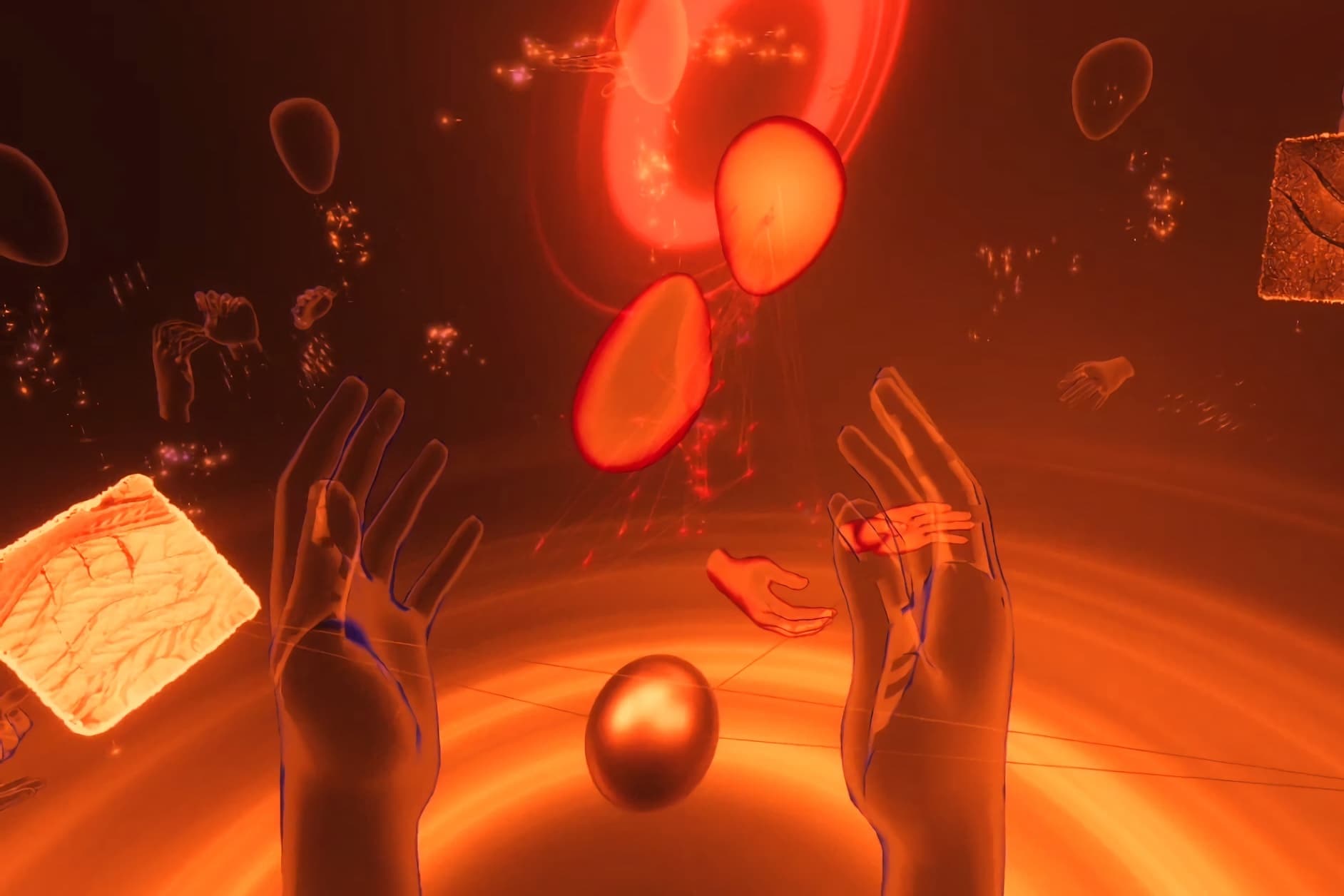
Creative Exchange: The IDFA DocLab R&D Summit 2021 in retrospect
The IDFA DocLab R&D Program operates as a living lab and place for creative exchange during the annual International Documentary Festival Amsterdam. It explores specific research questions that arise from developments in the interactive and immersive storytelling field. Each year, an integral component of the IDFA DocLab research program is the R&D Summit, a think tank event for experts from all corners of the interactive and immersive storytelling industry to (re)connect with their peers around specific topics and share insights, questions, and recommendations that sprung from their various practices.
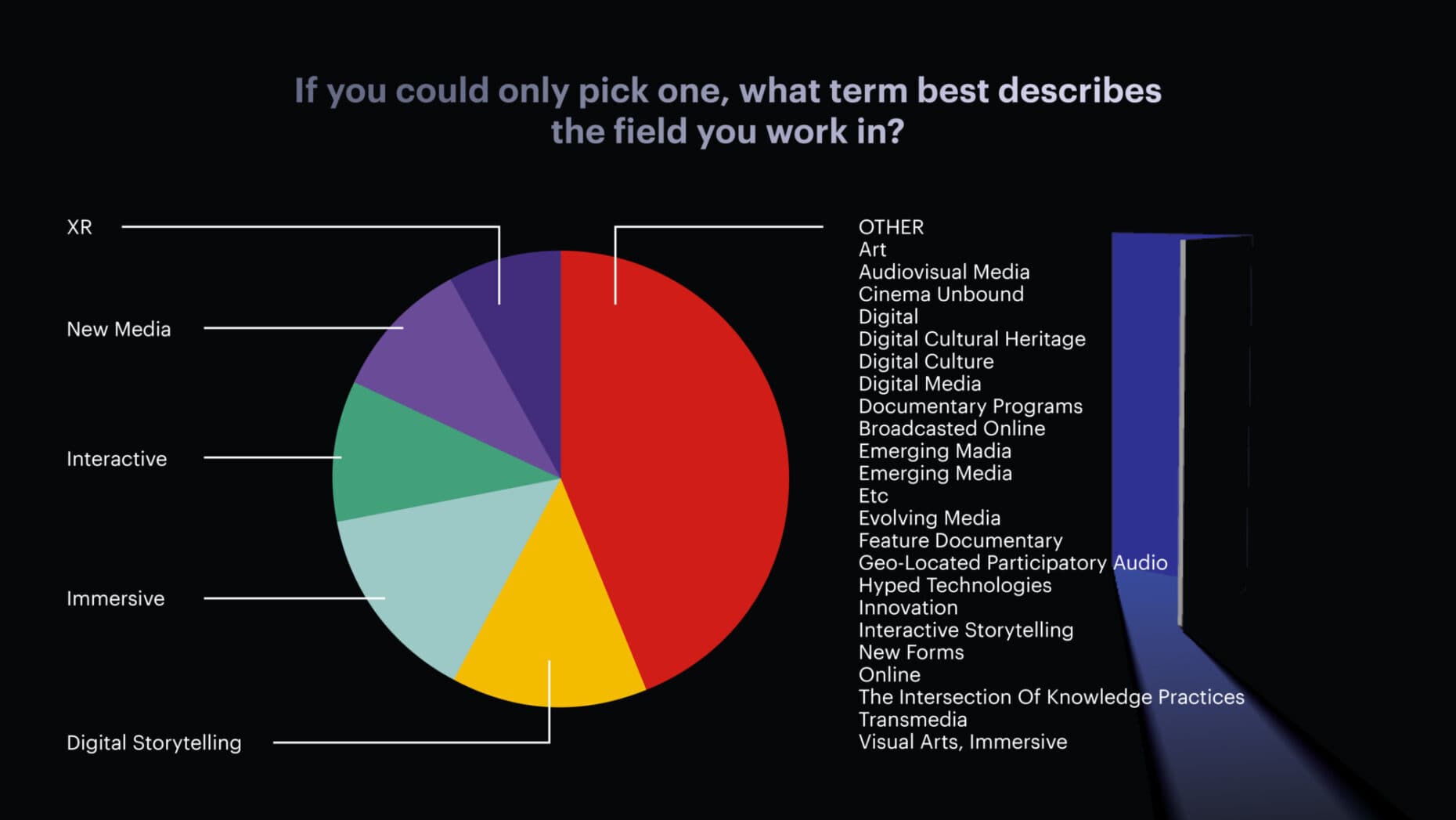
Compilation of reactions to a IDFA DocLab survey (October 2021) under industry professionals in the field of immersive and interactive storytelling.
With meetings taking place over two days, and with contributions from over fifty key industry players, the R&D Summit has proven to be a fruitful ground for forging new collaborations and research alliances. Artists, curators, creative technologists, and researchers gather around topics ranging from accessibility, preservation, distribution, and sustainability to public space, funding, the museum, audiences, and co-creation. The set-up is simple. Each participant brings their unique perspective and experience they gained from their research, failures and successes, case studies, cross-sector expert meetings, prototypes, demos, and experiments, to a 45-minute round table conversation. This article reflects the main threads of these meetings with the hope of fostering future discussions.
In response to COVID-19 measures, the 2021 R&D Summit took place as a hybrid event. On-site in Amsterdam (Tolhuistuin and A Lab) and online via a custom-built set-up by ohyay. Both setups allowed summit participants to meet through IDFA DocLab’s Liminal Reality program exhibition, that featured work of some of the summit participants, including Anagram, Atlas V, Anna Fries, Caroline Robert, Hakeem Adam, Joanne Popinska, Malu Peters, Polymorf, Tamara Shogaolu, and Rahima Gambo.
Politics of the Metaverse
The Summit-proceedings that informed the writing of this article, signal recurring themes. The ontology of the impending metaverse was certainly a topic of discussion. Metaverse, as an IDFA DocLab survey from last year (spread among professionals in the immersive field) points out was the 2021 buzzword that provoked both awe and annoyance. But what do we mean when we talk about the metaverse?
Coined by Neal Stephenson in his 90s cyber punk parody novel Snow Crash, and generally understood as a persistent, embodied, virtual reality-based internet—the term metaverse is now also heavily associated with the recent Facebook rebranding that propelled visions of the metaverse to the mainstream. While developments towards a third generation of the internet (Web3 or Web 3.0) potentially includes the AR/VR-based immersiveness Zuckerberg pursues, the intention for the next generation internet is to be decentralized, ubiquitous, transparent, and responsible, with multiple points of entry and a focus on accessibility. Virtues that Facebook does currently not excel at. Outgrowing the age of targeted advertising and lack of privacy—a new internet is ideally built and owned by all, and not just by a handful of Big Tech corporations. What potential do these developments offer (future) storytellers and interactive immersive artists?
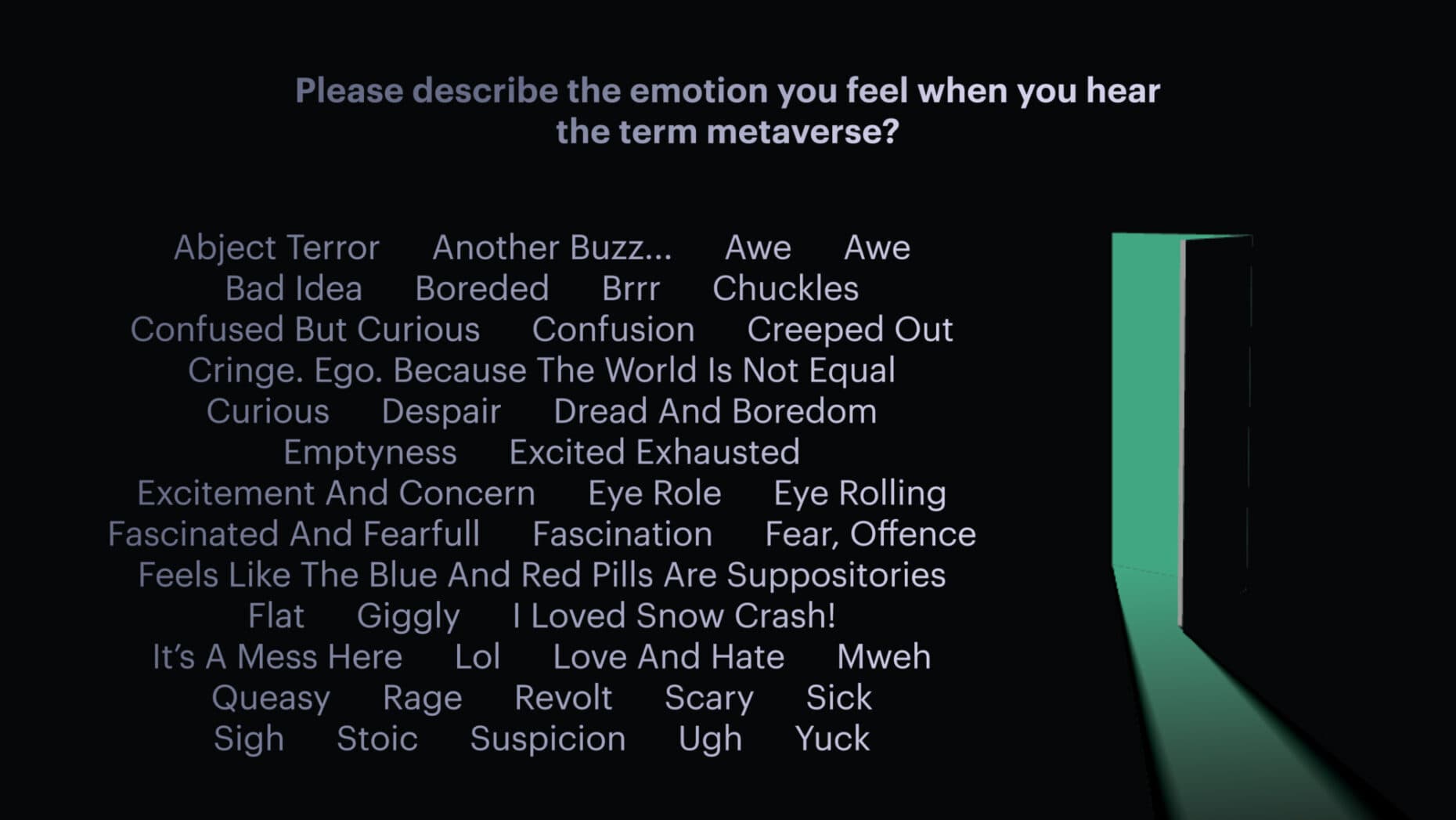
Compilation of reactions to the IDFA DocLab survey (october 2021) spread under 50 industry professionals.
Inspired by the idea of multiple points of entry and to experiment with the potential of ‘a metaverse’, IDFA DocLab teamed up with VR pioneers including Atlas V, The Metaverse Crew, and VRrooM last November to host a Messy Metaverse Party. In a 2.5 hour kaleidoscopic online gathering, guests could hop between online spaces and digital devices and peek into virtual worlds that are generally exclusively accessible by invitation and through VR headset.
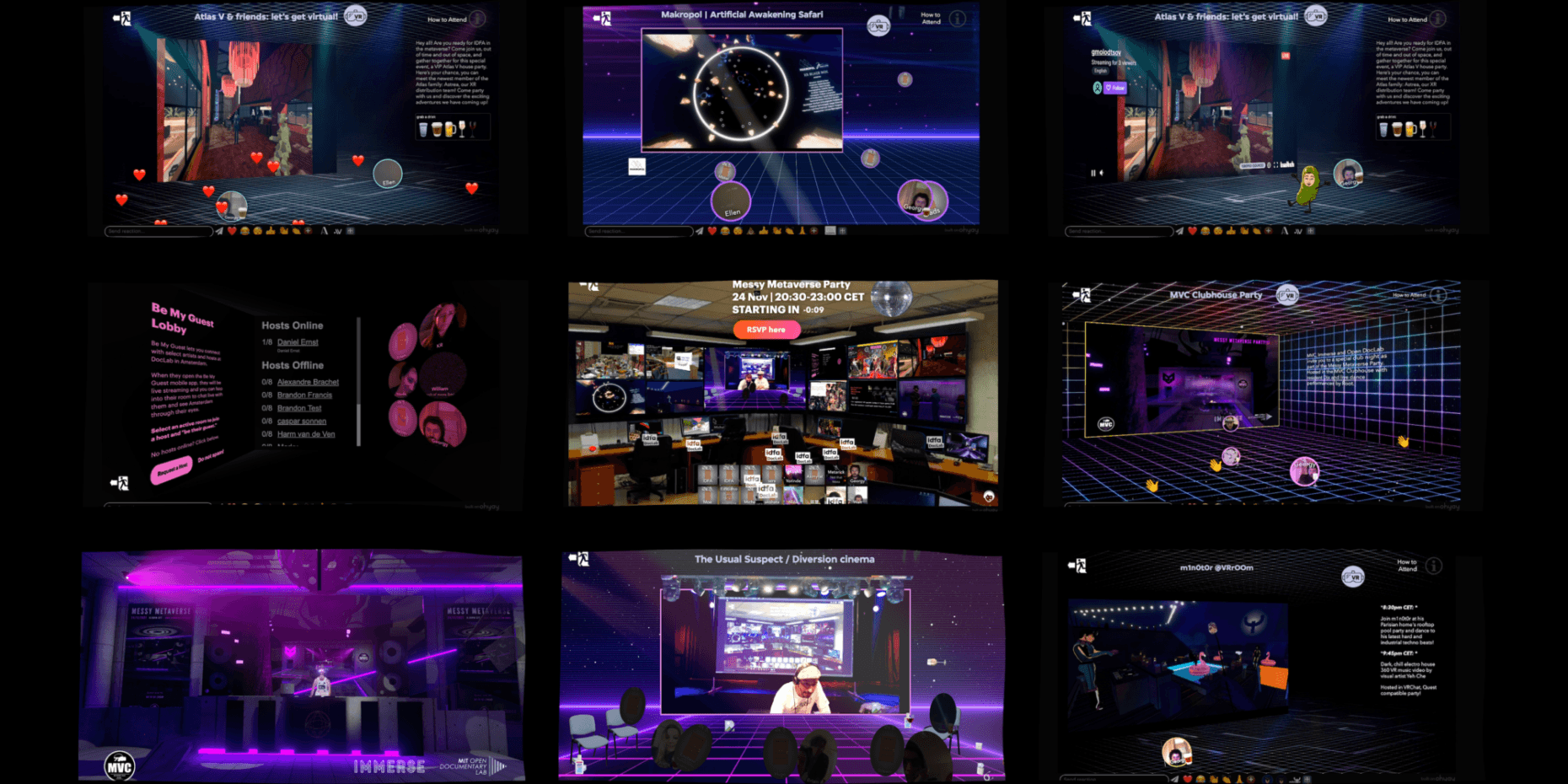
IDFA DocLab’s Messy Metaverse party in online and virtual worlds – 24 November 2021
Sustainable alternatives
Some advice and recommendations were formulated by experts during these summit discussions, such as the encouragement to explore (non-traditional) untapped spaces and resources and to build and demonstrate alternative platforms and counter-narratives in emerging tech. (Digital) storytelling is both a tool for teaching and learning. Starting with understanding how to use and assess technology ('tech literacy') is vital for creating a fair and sustainable digital future.
Showing such alternatives is something The Hmm, an inclusive platform for internet culture, is providing exciting examples of. Take for example the hybrid event On A Lighter Internet, that was hosted on a livestream website with different view-modes—high-res, low-res, audio, and text-only—to make the event more accessible and to explore what low-tech and low-data internet solutions can look like. Because even though blockchain technology seems a plausible foundation for new, decentralized online spaces—in its current form, the energy it consumes contributes significantly to global carbon emissions. In many countries unstable supply of electricity, downtimes in connectivity, and lack of access to (affordable) hardware are a daily occurrence. The global divide between people who have access to digital technology, and people who don’t, only continues to grow as energy-guzzling blockchain technology wins terrain. Read The Hmm’s full research dossier on ‘a lighter internet’ here.
Accessibility
The focus on sustainability and accessibility was prevalent in many R&D summit meetings. For the past several years, IDFA has worked hard to remove access barriers to create an inclusive festival experience. Both IDFA’s documentary film programming and the DocLab exhibition of immersive and digital art have the goal of being as accessible as possible to all members of the audience and professional guests. Unlike some art forms, interactive/immersive art requires direct and active engagement of audiences. To make immersive art accessible to different audiences, both context and networks of relationships must be carefully considered from the start, not as an afterthought.
Designing VR for someone in a wheelchair, for example, will impact the type of headset chosen, content design, and staff training required for exhibition. The VR experience [Posthuman Wombs] that premiered at IDFA DocLab 2021 paid special attention to onboarding audiences showing how to adjust the headset and how to use the controller in very simple steps which helped people to be confident using the technology. The IDFA DocLab award winning project Museum of Austerity also approached audience participation holistically and offered various versions of the work for audiences with varying degrees of visual or auditory impairments. One recommended tool that interactive/immersive artists may use to balance artistic expression with audience needs, is the Balance of Fairness triangle that is often used in documentary ethics.
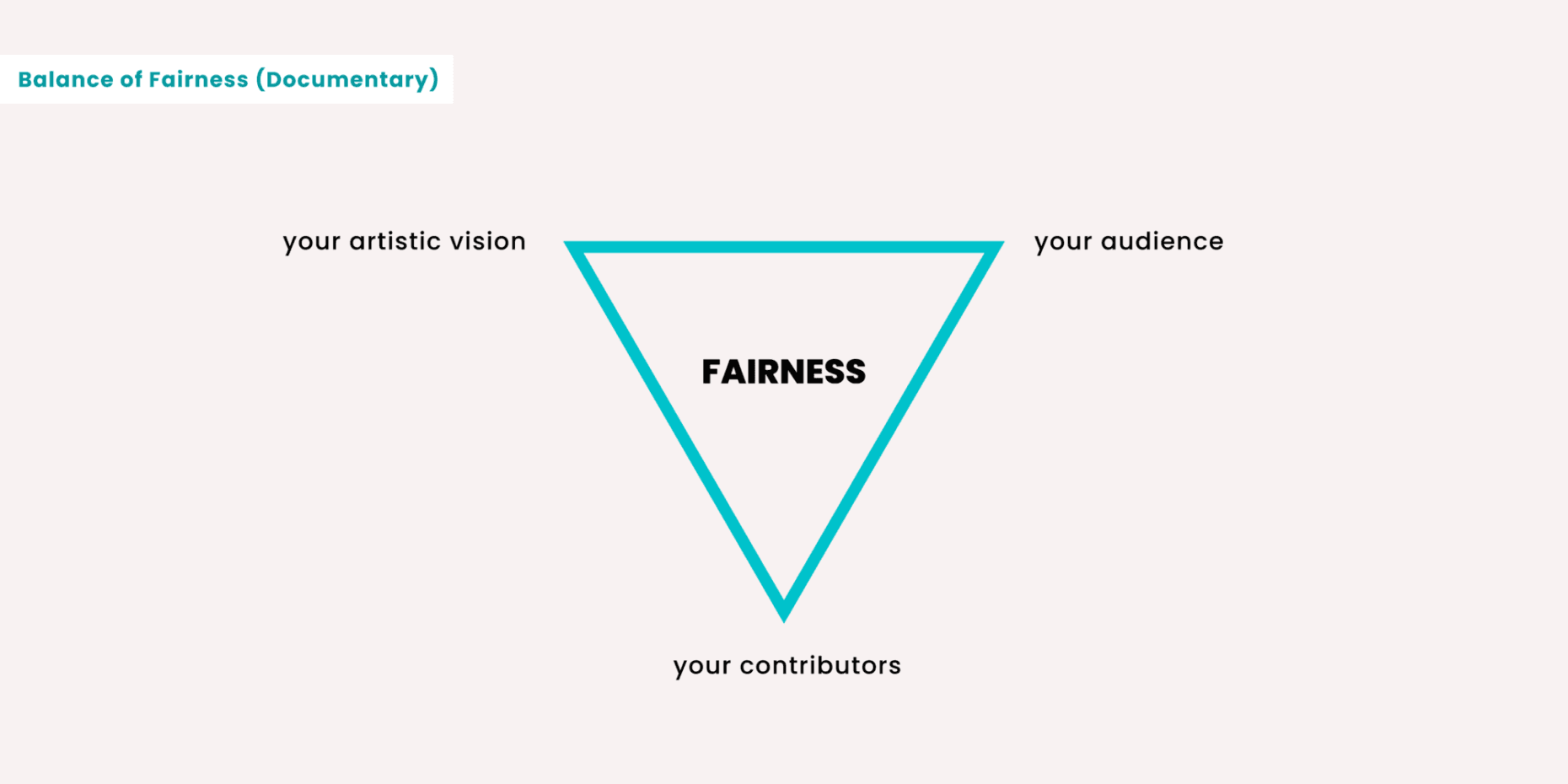
The Balance of Fairness triangle, used in documentary ethics.
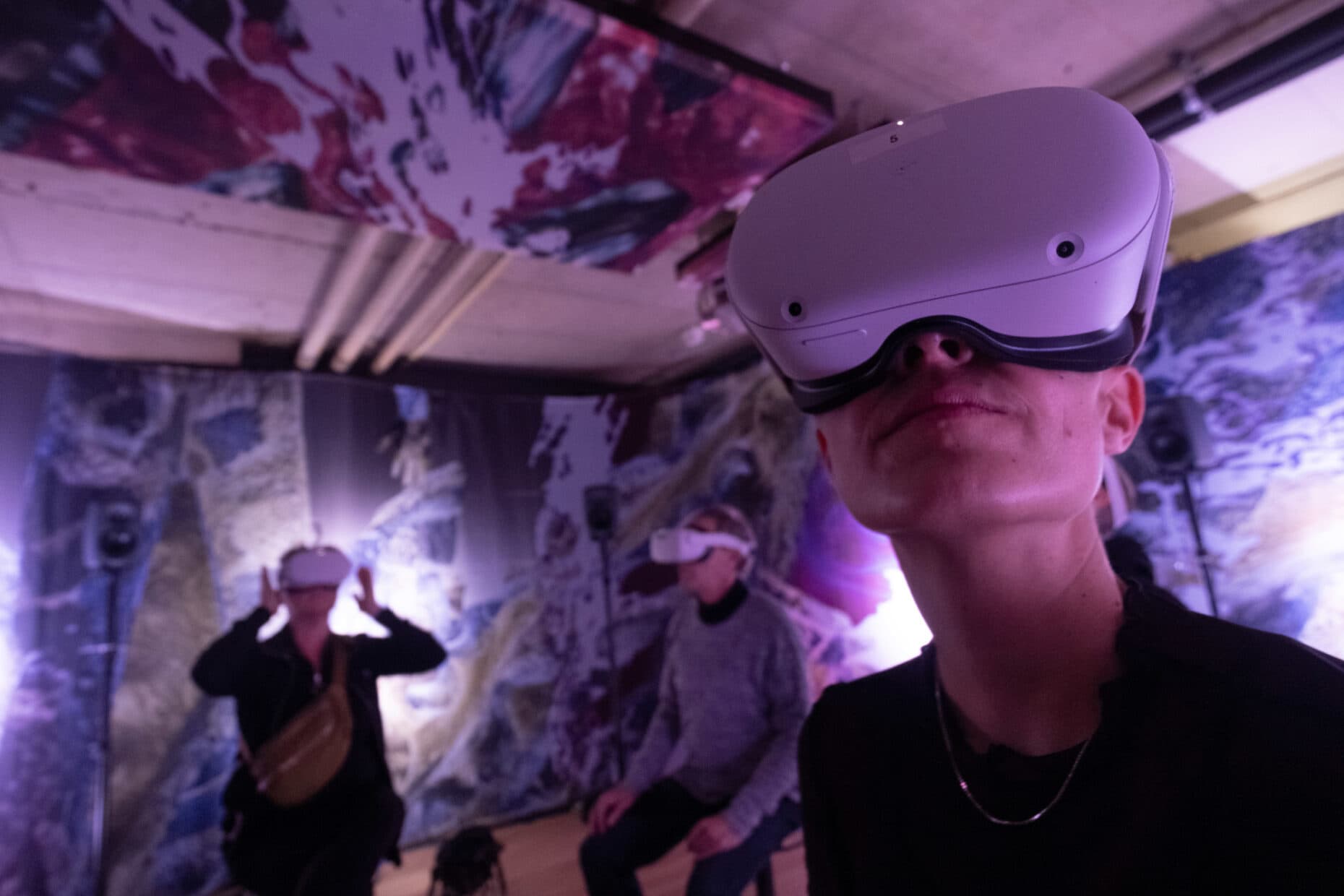
The VR experience [Posthuman Wombs] by Ana Fries and Malu Peeters. Installation view at IDFA DocLab exhibition Liminal Reality at Tolhuistuin 2021.
Unformatted Forms
Different challenges arise for museums, which operate differently to festivals and galleries. One such challenge is that immersive and interactive artworks are often hard to label, a convention that is still very much used and expected in museums.
Fulldome is one example of an unformatted form of immersive art, that is developing and maturing alongside VR, but is often hard for artists to get access to, and for curators to present. At present, each artist is required to be a pioneer as they carve out their individual fulldome careers. However, there is a growing interest in the fulldome medium and development of 360° creative content from gaming companies and commercial organizations. This contributes to the expansion of the fulldome medium and increases creative and commercial opportunities for established and emerging fulldome artists. As a result, the number of opportunities available to artists creating fulldome content has increased. In addition to SAT’s well-established Residency Program, the Market Hall’s Start Something Immersive program, CultVR’s Immersive Arts Residency and Virtual Exhibition, the New Infinity’s fulldome commission for Berliner Festspiele, ARTIS-Planetarium’s creative partnership with IDFA DocLab provides creative opportunities for artists to engage with the fulldome medium.
The DocLab Live: Elastic Presence event at ARTIS-Planetarium in November 2021, included Pedro Rodolpho Ramos work Saravá, a poetic lecture and a live performance, playfully exploring the affordances of a fulldome environment. Looking back, since the previous IDFA DocLab R&D Summit meetings (2019 & 2020) there has been significant advancement in VR technologies that provide 360° virtual fulldome spaces. Festoon software, for example, offers a virtual replica of real-world fulldome venues within a VR environment, making the full-dome a more accessible medium for artists to work with.
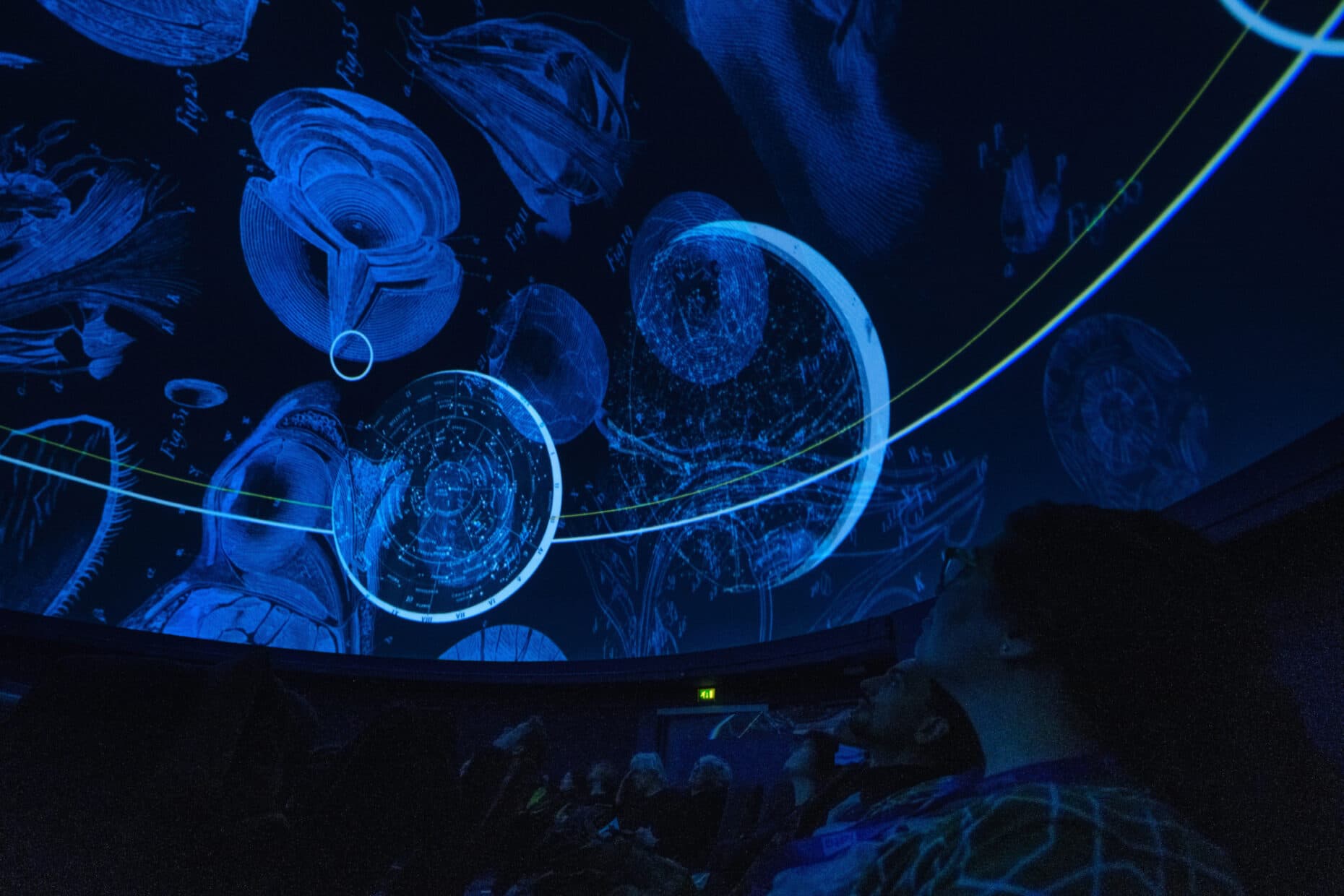
Performance lecture by Michaela French during IDFA DocLab Live: Elastic Presence at ARTIS-Planetarium, November 2021. Photo by Coen Dijkstra.
Co-creation
Whatever the medium, when technology fails, it is vital to fall back on a strong network of people. With immersive and interactive documentary storytelling projects, co-creation across disciplines is common. But how do you co-create? What are the methodologies and how do crises, such as the ones caused by the pandemic, change the global reception to co-creation?
United in the idea that by sharing and learning we contribute to transparent, open, and public knowledge frameworks, The Co-Creation Studio—that is part of IDFA DocLab’s R&D partner MIT Open Documentary Lab—researches and incubates collective creation as alternatives to singular authorship. Co-creation, according to this studio, can happen within communities, across disciplines, and more speculatively with non-human systems such as slimemolds and Artificial Intelligence. A ten-point manifesto produced by The Co-Creation Studio includes the advice to make media from within communities and with people, rather than for or about them, and to reframe who gets to tell which story, who owns it and why, grounded in principles of racial equality, narrative sovereignty and digital justice. An upcoming book on the subject, called Collective Wisdom: Co-Creating Media for Equity and Justice will be published in Fall 2022 with MIT Press.
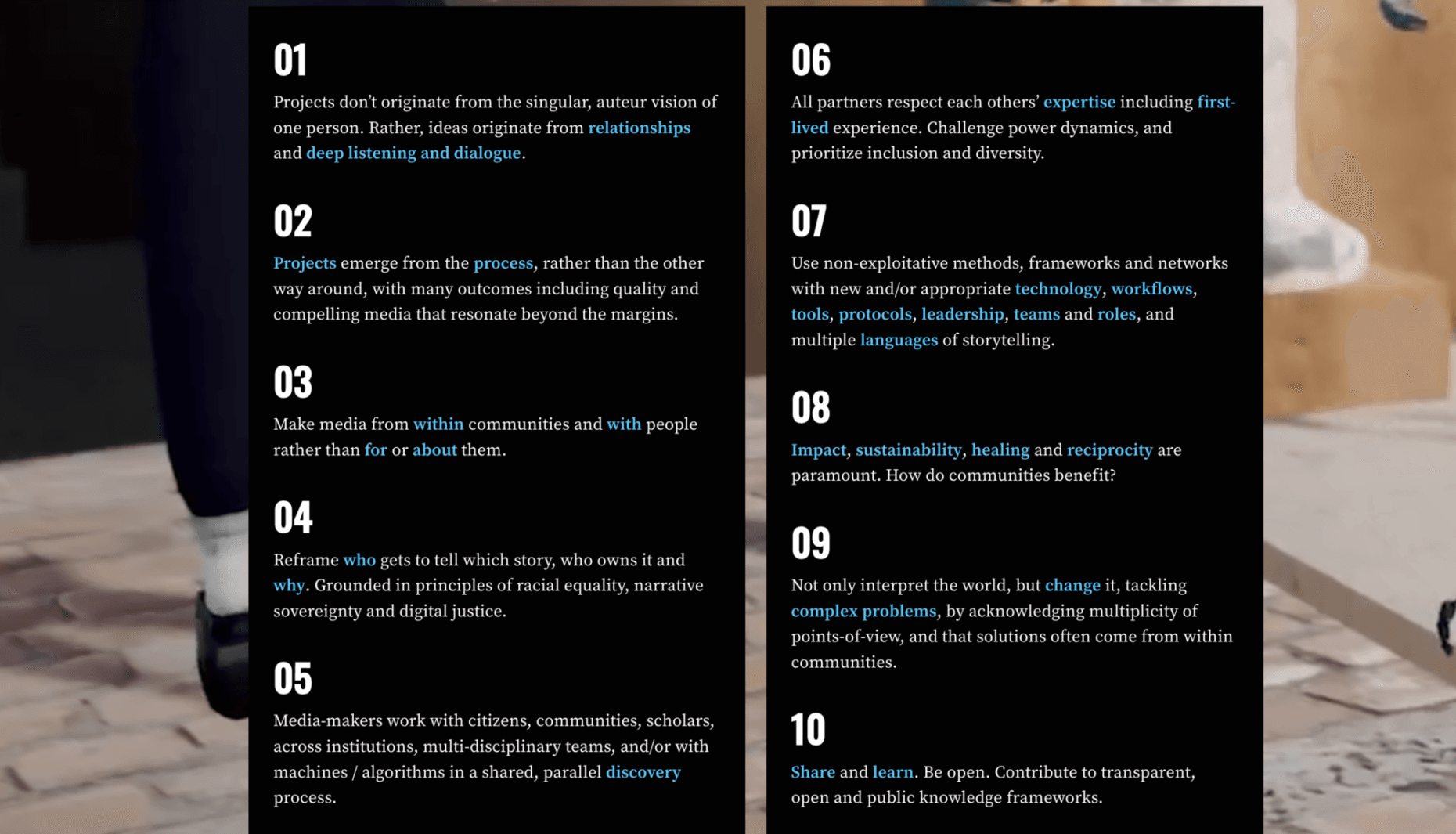
The Co-Creation Manifesto - by MIT Open Documentary Lab’s Co-Creation studio.
This case-study on the production process of the interactive web documentary Do Not Track is an example of this—developed by various creators under the conditions of an ‘agile’ working method, borrowing from web and tech development, as well as filmmaking, in search of the best process for the form. It was also noted that co-creation methodologies do not always integrate well with the established funding or distribution models.
Distribution
During the R&D summit, participants also shared and explored strategies for finding audiences online and offline for (unformatted) interactive digital art and storytelling. Mostly due to the pandemic, festivals experimented with various forms of hosting online, virtual, and hybrid events. For example, last year’s IDFA DocLab's Live: Gaming Reality event (created in collaboration with immersive media artists Anagram) attempted to bridge the gap between online gaming communities (joining the event through a Twitch live stream) and the ‘IRL’ IDFA audience in Amsterdam. Graphic programmer Leon Denise performed live creative coding using input from both on- and offline audiences to create generative imagery, and Jon, the man behind the VR experience Goliath, joined from his stream for a live playthrough of the experience with his own behind-the-scenes commentary. In the DocLab exhibition, the hybrid one-on-one theater performance TM, invited online and physical audiences to interact with the online and physical actors of Ontroerend Goed and during the IDFA DocLab Messy Metaverse party, Makropol connected virtual, digital, and physical audiences in a special rendition of Artificial Awakenings.
Another example is Hybrid Spaces, an Affect Lab initiative, was a year-long experimental research project exploring the intimate connections between online and physical audiences. Their findings have been summarized in this publication. Likewise, during NFF Extended: Hybrid Spaces—an event in collaboration with the Dutch Film Festival, IDFA DocLab, and STRP Festival in Eindhoven— curators and storytellers took stock, evaluating what opportunities have been discovered and what had been less successful.
Interestingly, after March 2020, some festivals saw an increase in attendance compared to in-person participation, but it is likely that attendance to online events may be waning as pandemic restrictions shift and online fatigue sets in. In terms of hardware accessibility, while stand-alone headsets such as Oculus Quest are finding mainstream traction, they are expensive and not all experiences and social platforms are compatible with non-PC headsets, limiting potential audiences.
Currently, there is no streamlined model to publish interactive projects to online platforms. One of the reasons is that most projects need an individualized plan and require specific things of platforms. Reliance on big platforms in general, limits independent control on project visibility. However, there are numerous examples of projects that have found their way to new platforms and exhibition spaces. The multisensory VR experience Symbiosis by Polymorf (co-presented by IDFA DocLab and Eye Xtended in 2021) was showcased at Holland Festival 2022, while Rahima Gambo’s multimedia project A Rest Guide for a Tired Nigerian Artist, and Studio Moniker’s VR experience Disarmed are both featured at this year’s Sheffield DocFest, to name a few.
Conclusion
DocLab R&D Summit 2021 covered a wide range of topics relevant in the field of immersive and interactive storytelling. Both inspired and restricted by COVID-19 restrictions of the past couple of years, artists, curators, and researchers shared their experiences and most valuable learning moments. The cross-pollination that took place between different people from various fields of expertise within technology, art, and academic research, created an exciting mixture of new ideas. The links and references in this article hope to encourage to join the discourse, find partnerships, and explore exciting projects. If you are interested in finding out more, please contact us.
On Thursday 15 September IDFA DocLab 2022 will kick off online. The next IDFA DocLab R&D Summit will take place in Amsterdam on Sunday, November 13, 2022. More information will be published in the coming months leading up to the festival.
____________________
This report by Nina van Doren was based on contributions by the IDFA DocLab R&D Summit participants, including:
Aja Evans, Alton Glass, Ambar Reyes-Lopez, Amy Dotson, Angelique Spaninks, Anna Abrahams, Anna Fries, Anne-Sophie Cunin, Annnelies Termeer, Babette Wijntjes, Barry Gene Murphy, Brian Chirls, Caroline Robert, Danielle B Giroux, Eleanor Whitley, Felix Gaedtke, Francesca Panetta, Georg Hobmeier, Hakeem Adam, Ingrid Kopp, Innocent Ekejiuba, Joanne Popinska, Johanna Musch, Judith Okonkwo, Julia Yudelman, Kat Cizek, Lilian Stolk, Luke Moody, Malu Peeters, Margarita Osipian, Margaux Missika, Marianne Lévy-Leblond, Marieke Nooren, Marion Burger, Mark Atkin, Maxime Montagne, Miriam Natroshvili, Myriam Achard, Oriane Hurard, Paul Bouchard, Pepijn Lemmens, Piotr Winiewicz, Rahima Gambo, Sarah Wolozin, Shanida Scotland, Shari Frilot, Sonia Epstein, Srushti Kamat, Tamara Shogaolu, Tom C. Hall, Ulrich Schrauth, Vincent Morisset, William Uricchio, Yannik Noomen, Zillah Watson, Ziv Scheider.
And collectives:
Atlas V, Astrea, Makropol, We Make VR, Go East, Phi Centre, Immerse, MIT Open DocLab, the Metaverse Crew, the Metamovie, VRrOOm, Mozfest, Public Spaces, Cie Gilles Jobin, Diversion cinema, Popkraft, Upian, and Ohyay.